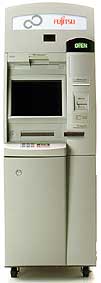News
Opening Windows
While everyone is talking about Windows NT, Fujitsu/ICL opts to use Windows 2000 as the operating system of choice on its new 8000 Series ATMs.
February 21, 2002

While the ATM industry is slowly migrating away from OS/2 and toward Windows NT as the operating system of choice for its machines, at least one manufacturer thinks it makes more sense to move directly to Microsoft's latest release, Windows 2000.
"We know it's a very stable program – a lot of people are running it on their desktops – and it's easily integrated into current Windows-based platforms – whether they're wireless or branch systems or PC banking systems," said Kent Schrock, financial marketing consultant for Fujitsu-ICL Systems.
Fujitsu-ICL is debuting its new line of ATMs, the 8000 Series, at this week's BAI Retail Delivery Conference in New Orleans. "At the show, and for the foreseeable future, we think we'll be the only vendor with Windows 2000," Schrock said.
An early adopter of NT, Fujitsu-ICL had implemented it on its previous generation of machines, the 7000 Series, for a pilot with First Union Bancorp. It was a case of "fortuitous timing," Schrock said, that Fujitsu-ICL began developing its new machine shortly after Microsoft introduced Windows 2000.
Lauding Windows 2000's stability and ability to simultaneously display information from multiple sources, Schrock called it "probably the best platform for Web-enabled transactions."
Schrock – and others in the industry – believe that the market for Internet-enabled applications may be heating up as some of the early retail ATM contracts begin to expire.
When Fujitsu-ICL introduced its 7000 Series ATMs in 1995, there were approximately 122,700 ATMs in the U.S. -- and only about 30 percent of them were at sites other than bank branches. According to Bank Network News, that number has grown to 273,000 machines today, with about 57 percent of them in retail locations.
The retail ATM explosion was driven almost exclusively by the surcharge. But as transaction volumes drop, some deployers are starting to explore the possibility of delivering products and services other than cash dispensing at their machines.
"Banks and some independents realize they need to deliver more than cash, and they can't do that now with the boxes they have," Schrock said. "These units may replace what you see out there now."
Fujitsu-ICL tweaked the design of its new machines to make them more suited to a retail environment. The biggest change: a dramatically reduced footprint. Another major design modification, Schrock said, is the 8000 Series' adherence to proposed changes in the Americans with Disabilities Act (ADA) guidelines. An audio jack and ADA-approved keyboard are standard features, for instance.
Another trend that Fujitsu-ICL hopes to capitalize on with its 8000 Series is Internet banks' interest in using ATMs as "virtual branches." At RDS, Fujitsu-ICL will team with USABancShares.com to demonstrate a variety of banking applications – including bill payment and online credit card and loan applications -- on the new machines.
Fujitsu-ICL has already signed its first contract for the 8000 Series with Allfirst Financial Inc., a Baltimore-based financial institution with assets of $18 billion. A Fujitsu client since 1987, Allfirst plans to deploy 79 of the new ATMs in the first quarter of 2001. The bank intends to replace 150 or so of the 600 legacy machines in its network with the 8000 Series over the next three years.
"We wanted to invest in technology that would take us where we needed to go in the next five to 10 years," said Heather Briganti, Allfirst's vice president of electronic banking.
The 8000 Series fits in nicely with Allfirst's strategy of offering customers "a common look, feel and functionality across devices," Briganti added, noting that the ATM is "one more extension of the bank."
Allfirst is interested in Web-enabled applications such as bill payment, Briganti said. "It won't be long before people expect to be able to do the same things at the ATM that they can do from their desktop."









